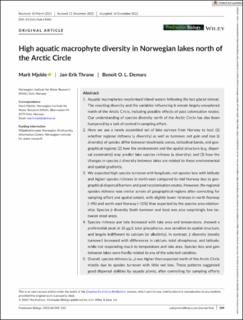| dc.description.abstract | 1. Aquatic macrophytes recolonised inland waters following the last glacial retreat. The resulting diversity and the variables influencing it remain largely unexplored north of the Arctic Circle, including possible effects of past colonisation routes. Our understanding of species diversity north of the Arctic Circle has also been hampered by a lack of control in sampling effort. 2. Here we use a newly assembled set of lake surveys from Norway to test: (1) whether regional richness (γ diversity) as well as turnover, net gain and loss (β diversity) of species differ between bioclimatic zones, latitudinal bands, and geographical regions; (2) how the environment and the spatial structure (e.g. dispersal constraints) may predict lake species richness (α diversity); and (3) how the changes in species β diversity between lakes are related to these environmental and spatial gradients. 3. We expected high species turnover with longitude, net species loss with latitude and higher species richness in north-east compared to mid Norway due to geographical dispersal barriers and past recolonisation routes. However, the regional species richness was similar across all geographical regions after correcting for sampling effort and spatial extent, with slightly lower richness in north Norway (−4%) and north-east Norway (−11%) than expected by the species area relationship. Species β diversity (both turnover and loss) was also surprisingly low between most areas. 4. Species richness per lake increased with lake area and temperature, showed a preferential peak at 10 μg/L total phosphorus, was sensitive to spatial structure, and largely indifferent to calcium (or alkalinity). In contrast, β diversity (mostly turnover) increased with differences in calcium, total phosphorus, and latitude, while not responding much to temperature and lake area. Species loss and gain between lakes were hardly related to any of the selected variables. 5. Overall, species richness (α, γ) was higher than expected north of the Arctic Circle mostly due to species turnover with little net loss. These patterns suggested good dispersal abilities by aquatic plants, after controlling for sampling efforts and spatial extent. Conservation of aquatic plants should not be driven by the delineation of terrestrial vegetation zones, but through an understanding of the variables affecting aquatic plant diversity. Finally, northern lakes may be increasingly important as reservoirs of macrophyte diversity under global warming. | en_US |

